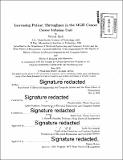| dc.contributor.advisor | Charles Sodini and Retsef Levi. | en_US |
| dc.contributor.author | Rieb, Wendi | en_US |
| dc.contributor.other | Leaders for Global Operations Program. | en_US |
| dc.date.accessioned | 2015-11-09T19:52:37Z | |
| dc.date.available | 2015-11-09T19:52:37Z | |
| dc.date.copyright | 2015 | en_US |
| dc.date.issued | 2015 | en_US |
| dc.identifier.uri | http://hdl.handle.net/1721.1/99844 | |
| dc.description | Thesis: S.M., Massachusetts Institute of Technology, Department of Electrical Engineering and Computer Science, 2015. In conjunction with the Leaders for Global Operations Program at MIT. | en_US |
| dc.description | Thesis: M.B.A., Massachusetts Institute of Technology, Sloan School of Management, 2015. In conjunction with the Leaders for Global Operations Program at MIT. | en_US |
| dc.description | Title as it appears in MIT Commencement Exercises program, June 5, 2015: Improving throughput in the MGH Cancer Center Infusion Unit. Cataloged from PDF version of thesis. | en_US |
| dc.description | Includes bibliographical references (pages 104-107). | en_US |
| dc.description.abstract | This thesis proposes an appointment scheduling algorithm with associated supporting process changes that increases the effective capacity of the Massachusetts General Hospital Cancer Center Infusion Unit. Currently, chair and bed utilization in the Infusion Unit is concentrated between 10am-2pm, Monday through Friday, but remains underutilized during other operating hours. This uneven use of resources has resulted in highly strained staff and physical resources during rush hour, causing the perception of insufficient capacity. Moreover, when the environment is highly congested, patients experience long wait times and are more exposed to quality and safety problems. This study will recover unrealized capacity by smoothing the intra-day utilization of physical resources in the Infusion Unit. The scheduling algorithm is derived employing a retrospective integer program and validated using prospective simulation modeling. Implementation of these scheduling guidelines demonstrates the potential to recover 20 chairs, or 33% of capacity, at the average peak of each day, while smoothing throughput throughout the day. The proposed state can be achieved with minimal adjustments to staffing in the infusion unit and pharmacy, and no adjustment to staffing in the Oncology Practice. The algorithm also respects the existing primary nursing model, and treatment specific limitations. | en_US |
| dc.description.statementofresponsibility | by Wendi Rieb. | en_US |
| dc.format.extent | 107 pages | en_US |
| dc.language.iso | eng | en_US |
| dc.publisher | Massachusetts Institute of Technology | en_US |
| dc.rights | M.I.T. theses are protected by copyright. They may be viewed from this source for any purpose, but reproduction or distribution in any format is prohibited without written permission. See provided URL for inquiries about permission. | en_US |
| dc.rights.uri | http://dspace.mit.edu/handle/1721.1/7582 | en_US |
| dc.subject | Electrical Engineering and Computer Science. | en_US |
| dc.subject | Sloan School of Management. | en_US |
| dc.subject | Leaders for Global Operations Program. | en_US |
| dc.title | Increasing patient throughput in the MGH Cancer Center Infusion Unit | en_US |
| dc.title.alternative | Increasing patient throughput in the Massachusetts General Hospital Cancer Center Infusion Unit | en_US |
| dc.title.alternative | Improving throughput in the MGH Cancer Center Infusion Unit | en_US |
| dc.type | Thesis | en_US |
| dc.description.degree | S.M. | en_US |
| dc.description.degree | M.B.A. | en_US |
| dc.contributor.department | Leaders for Global Operations Program at MIT | en_US |
| dc.contributor.department | Massachusetts Institute of Technology. Department of Electrical Engineering and Computer Science | |
| dc.contributor.department | Sloan School of Management | |
| dc.identifier.oclc | 927412361 | en_US |
